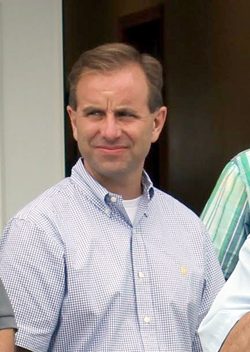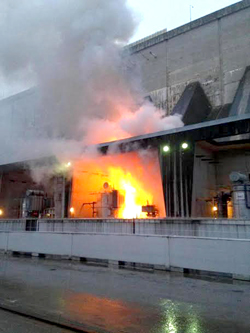NYPA Shortchanges Town by Not Paying for Fire Protection
By Craig Tretiak
 |
| Mike Marra wants NYPA to pay |
 |
| NYPA gets free fire protection. |
"This isn't exactly how any of us wanted to be proved right," said Lewiston Councilman Mike Marra last Thursday (Mar 20) commenting on the recent transformer explosion and fire at the New York Power Authority's Niagara Power Project.
Just 10 days before the fire, in an action that now seems prescient, a Town Board resolution seeking an "annual payment for police and fire protection" from the New York Power Authority (NYPA), authored by Marra, was passed unanimously at the March 10 board meeting.
"We ask town residents to pay a special district tax for fire and police protection, but because we can't tax the Power Authority... they pay nothing," Marra said.
NYPA, a public benefit corporation created by the New York State Legislature to provide "low-cost electricity to the people of New York," is situated on 2,400 acres of town land that might otherwise be used to generate taxes.
Contrary to popular belief, Niagara County residents do not get electricity from hydropower generated by NYPA, but from coal burning facilities at National Grid, a British multinational company headquartered in London.
Local (NYPA) hydropower is transmitted downstate to New York City and eight other states.
"Over the past six years, NYPA and NYS have taken over $1 billion from the Niagara Power Project to fund operations elsewhere," Rep. Brian Higgins said. "In 2008 alone, NYPA had a surplus of $309 million; 76 percent ($236 million) of which came from the Niagara.
"NYPA studies released prior to relicensing [2007] found that only 14% of the economic benefit from the Niagara Power Project remains in WNY," said Higgins.
The 2014 Town of Lewiston budget allocates $1.25 million to its volunteer fire companies, charging residents $1.78 per $1000 of assessed value tax rate.
Those payments help fund the operations of Upper Mountain, Lewiston No. 1, Lewiston No. 2, and Sanborn's volunteer fire companies all of which, along with the emergency response unit of the Niagara Air Reserve Station, responded to the recent NYPA blaze.
Ironically, these fire companies were thanked by a "grateful" NYPA in a press release issued Wednesday night while the fire still burned at the Power Project.
According to Marra, based on the land they own, and its value, NYPA should be paying more than $2 million annually toward fire protection.
"Whether we've wanted to or not, this community has always shouldered some of the burden for the Power Authority and the power it provides much of the rest of the state," said Marra.
While the town shoulder's the cost for fire and police services, according to an article in the Feb. 10, 2014 edition of the Albany Times Union, NYPA gave $435,845 in "diversity grants" to the National Hispanic Business Group, the Women's Research and Education Fund in Westchester County, the Somos El Futuro legislative conference, and Network Journal magazine, which used the funds to pay for a dinner to draw attention to its list of 25 influential black women in business, which "included NYPA's chief diversity officer, Sylvia B. Hamer."
NYPA also made a payment to the Oriskany, N.Y., Fire Department which provides fire service for one of NYPA's office buildings, the Frederick R. Clark Energy Center.
NYPA also gifted a private sector company, Groundwork Hudson Valley, Inc., $75,000 for a science barge.
NYPA documents on file with the Federal Energy Regulatory Commission suggest that the Niagara Power Plant presents a greater potential danger to fire fighters than office buildings or residential dwellings.
NYPA's "Assessment of Project Effects on Public Health, Safety, and Security," a 2005 document, reads, "[The] Niagara Power Project uses a series of industrial chemicals/substances that are typical of the utility sector…..wherever large rotating equipment is used and maintained and wherever electric power is generated and transmitted in large quantities."
The document lists industrial lubricants, such as turbine oil, transformer oil, dielectric fluid, solvents, refrigerants, chlorine, and asbestos that are onsite.
"A fire at the Power Authority is a bit more involved than the typical household," Marra said. "Yet they didn't even pay for the gas the fire trucks burned going to fight their fire."
All this while New Yorkers pay more than 16 cents per kilowatt hour, which is the second highest rate in the nation. Most of the rest of the nation pays around 10 cents.
"The Niagara Power Project is the key to NYPA's profitability," said Higgins. "No other place in the state can provide what Niagara Falls can."